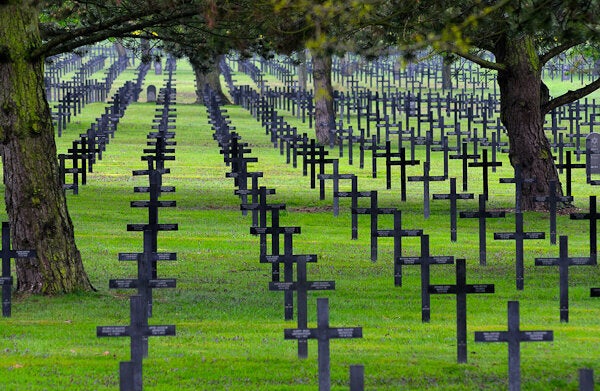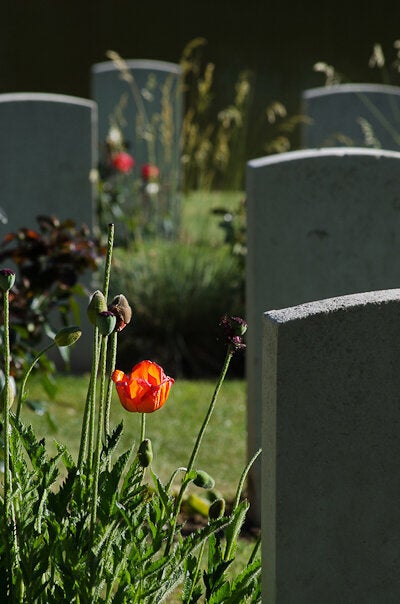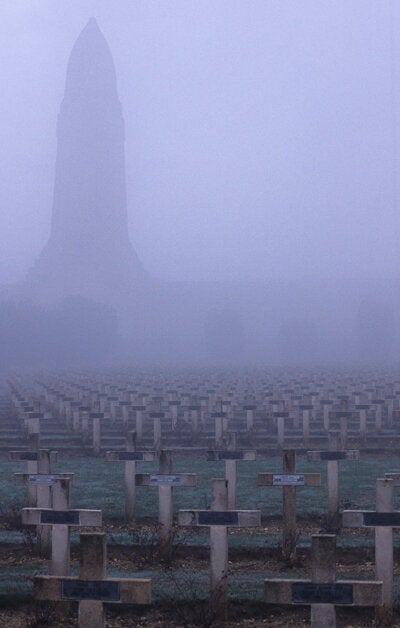Quietly and methodically, Germany has been recovering the bodies of hundreds of thousands of its soldiers who fell on its Eastern Front in the bloodiest campaign of the Second World War.
The country's war graves commission, Volksbund Deutsche Kriegsgräberfürsorge, inaugurated what officials said will be the last German military cemetery to be built in Russia, at Dukhovschina near the city of Smolensk, on August 3. Defence Minister Thomas de Maizière and a delegation of 200 people from Germany, including some descendants of the dead soldiers, attended the ceremony.
Dukhovschina will eventually contain the remains of 70,000 men, making it the biggest German war cemetery, and surely one of the largest of any nation. By the end of the year the Volksbund will have located the remains of 800,000 Wehrmacht and SS troops and reinterred them in refurbished and newly built cemeteries. It knows the locations of a further 400,000.
The search for war dead has been going on since the end of the Cold War in the early 1990s when the former Eastern bloc nations allowed German search teams to inspect hundreds of dilapidated and in many cases completely unmarked burial sites hastily dug during the fighting.
Some three million German soldiers fell in Eastern Europe and Russia. The Soviet casualties were far greater, with estimates putting Red Army losses at a staggering 11 million. Soviet civilian deaths were even higher, at 15 million or more.
The German cause was criminal, of course, and some of the 30,513 soldiers freshly interred in Dukhovschina may have personally committed war crimes and even been involved in the Holocaust. Most Germans today want to draw a line under that dreadful part of their history and the work of the Volksbund gets little public attention in Germany.
Few people alive today knew the men lying in this ground. Only a handful of relatives turned up to the ceremony in Dukhovschina, and it's unlikely that many will make the 1,500 kilometre trip in the future.
So why is Germany going to the trouble of reburying the remains now?
One argument is that the country owes it to the men, both legally and morally. This isn't misplaced hero worship or historical revisionism. The constitution obliges the government to maintain war graves. And it is right that they should be laid to rest in dignity and their names be recorded on headstones or on monuments to the missing.
But more importantly, war cemeteries of all nations have a significance that goes far beyond the rights of the fallen and their families. They are permanent monuments to the cost of war, and a vital reminder to the laptop and latte generations to stop taking peace and prosperity for granted. We are rapidly forgetting that the European Union is fundamentally about preventing our blood-soaked history from repeating itself.
The Eastern Front is far away. But there are thousands of British, Australian, Canadian, American, French and German cemeteries from both world wars much closer to home. It's worth visiting them.
Their styles differ. But their message is the same.

German war graves from the First World War, Neuville-St.Vaast, France
Many of the Commonwealth cemeteries are like beautiful gardens with flowers and perfectly trimmed lawns. They are tended with a loving dedication that makes these sites, with their endless ranks of rectangular headstones of Portland stone, all the more achingly poignant.
They radiate gentle sorrow, respect and love for a lost generation, and the only evident wear and tear is in the form of trampled grass from the thousands of British schoolchildren who make pilgrimages across the channel.
Some of the cemeteries are very small, containing just a few dozen men buried where they fell. But whatever their size, they retain a personal quality, often aided by individual inscriptions on their bases.

British First World War cemetery in Ypres
Many French cemeteries aren't as well maintained as the British graveyards. They are colder and more impersonal, with oceans of greying stone crosses stretching into the distance. But what they lack in warmth is more than made up for by the war memorials in villages and towns, with designs full of eloquent grief.
The American cemeteries are as pristine as the British ones, but there's no gentleness here, and their muscular white marble headstones evoke military pride, as if the soldiers are still on parade.
German cemeteries are devoid of any beauty, let alone pride, but that makes them all the more effective.
Head to the village of Neuville-St. Vaast near Arras in the department of Pas-de-Calais, walk to the centre of this enormous field of black iron crosses and you will get a sense of the indescribable waste of life, and the horrific, barely imaginable scale of the disaster that was the First World War. It screams out at you in the silence of this cemetery of 44,833 soldiers, and explains better than words what went wrong with the 20th century and why we should never forget its lessons.
These are valuable places. Tony Blair and George W. Bush would have benefited from visiting them before senselessly launching the Iraq war.
German Chancellor Angela Merkel, whose reluctance to show solidarity with European nations exacerbated the euro crisis, should tour the battlefields to learn what the European project is really about.
She still hasn't grasped it, and neither has David Cameron, who is putting Britain's membership of the EU at risk even as he prepares to launch a 50-million-pound plan to commemorate the centenary of the outbreak of the First World War in 2014.

The French national cemetery at Douaumont, Verdun